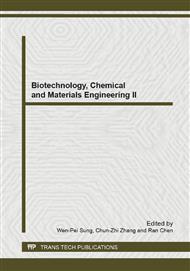[1]
Q. Y. Liu, Y. B. Zhang, D. F. Zhao, C. C. Zhao, Bioremediation Condition Optimization of Hydrocarbon in Soil Using Response Surface Methodology by Microbial Consortium KL9-1. Advanced Materials Research. 518 – 523(2012) 2073-2078.
DOI: 10.4028/www.scientific.net/amr.518-523.2073
Google Scholar
[2]
H. P. Wang, The Study on Oil Pollution Environmental Treatment Based on Micro-Biological Degradation. Advanced Materials Research. 490 – 495(2012) 1743-1747.
DOI: 10.4028/www.scientific.net/amr.490-495.1743
Google Scholar
[3]
H. Guang, J. H. Wang, D. Cui, X. Liu, S. S. Feng, Analysis of Low-Temperature Oil-Degrading Bacteria for Municipal Wastewater in Northern Winter. Advanced Materials Research. 347 – 353(2011) 2028-2032.
DOI: 10.4028/www.scientific.net/amr.347-353.2028
Google Scholar
[4]
M. Lee, S. Woo and L. N. Ten, Characterization of novel diesel-degrading strains Acinetobacter haemolyticus MJ01 and Acinetobacter johnsonii MJ4 isolated from oil-contaminated soil. World J Microbiol Biotechnol. 28 (2012) 2057-2067.
DOI: 10.1007/s11274-012-1008-3
Google Scholar
[5]
J. Chen, P.T. Huang, K.Y. Zhang and F.R. Ding, Isolation of biosurfactant producers, optimization and properties of biosurfactant produced by Acinetobacter sp. from petroleum-contaminated soil. Journal of Applied Microbiology.112 (2012) 660-671.
DOI: 10.1111/j.1365-2672.2012.05242.x
Google Scholar
[6]
Austin, B., Microbiological Methods: Marine Microbiology. Cambridge University Press, Cambridge, UK,1993, p.24.
Google Scholar
[7]
T. Bauchop and S. R. Elsden, The growth of microorganisms in relation to their energy supply. Journal of General Microbiology. 23(1960) 457–569.
DOI: 10.1099/00221287-23-3-457
Google Scholar
[8]
Sambrook, J., Fritsch, E.F., Maniatis, T., Molecular Cloning: a Laboratory Manual, 2nd ed. Cold Spring Harbor Laboratory, Cold Spring Harbor, New York, 1989.
DOI: 10.1002/jobm.19840240107
Google Scholar
[9]
A. Nemec, M. Musilek, M. Maixnerova, T. D. Baere, T. J. K. van der Reijden, M. Vaneechoutte and L. Dijkshoorn, Acinetobacter beijerinckii sp. nov. and Acinetobacter gyllenbergii sp. nov., haemolytic organisms isolated from humans. Int J Syst Evol Microbiol.59(2009) 118-124.
DOI: 10.1099/ijs.0.001230-0
Google Scholar


